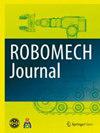一种适于多旋翼飞机悬停的欠驱动平行连杆夹持器
IF 1.7
Q3 INSTRUMENTS & INSTRUMENTATION
引用次数: 2
摘要
在救援和运输领域,对栖息机器人的需求正在增加。因此,进行了通过在栖息机器人上附加机械臂来栖息物体的研究。然而,几乎所有与栖息有关的研究都是使用驱动装置或电动装置进行的。然而,通过使用电动装置栖息有几个缺点,例如额外的电力消耗和用于加载电源的多旋翼机质量的增加。而不是使用电动装置,通过使用欠驱动夹持器可以有效地避免这些缺点。因此,我们开发了一种欠驱动无源夹持器,该夹持器具有不消耗栖息电力的优点。确定稳定栖息的可用范围是使用欠驱动被动夹持器的问题之一。因此,在本研究中,我们分析了一架多旋翼飞机携带一种欠驱动并联无源夹持器,以供飞机停泊。为了在不同厚度、不同埋深的平面上实现可栖,基于摩擦锥理论总结了可栖范围和局限性。我们的结论得到了理论和实验结果的支持。本文章由计算机程序翻译,如有差异,请以英文原文为准。
An underactuated parallel-link gripper for a multicopter capable of plane perching
The need for a perching robot is increasing in the field of rescue and transportation. Accordingly studies on perching an object by attaching a robot arm to a perching robot have been conducted. However, almost all the studies related to perching have been conducted using an actuated or electric device. However, perching by using an electric device has several disadvantages, such as additional power consumption and an increase in the mass of the multicopter used to load the electric source. Instead of using an electric device, perching by using an underactuated gripper can effectively avoid these disadvantages. Accordingly, we developed an underactuated passive gripper that has the advantage of nonconsumption of electric power for perching. A method to confirm the available range for stable perching is one of the problems of using an underactuated passive gripper. Therefore, in this study, we analyze a multicopter carrying an underactuated parallel-link passive gripper for available plane perching. To enable perching on planes with different thicknesses and being embedded at different depths, we summarize the available perching range and limitations based on the friction cone theory. Our conclusion is supported by both theoretical and experimental results.
求助全文
通过发布文献求助,成功后即可免费获取论文全文。
去求助
来源期刊

ROBOMECH Journal
Mathematics-Control and Optimization
CiteScore
3.20
自引率
7.10%
发文量
21
审稿时长
13 weeks
期刊介绍:
ROBOMECH Journal focuses on advanced technologies and practical applications in the field of Robotics and Mechatronics. This field is driven by the steadily growing research, development and consumer demand for robots and systems. Advanced robots have been working in medical and hazardous environments, such as space and the deep sea as well as in the manufacturing environment. The scope of the journal includes but is not limited to: 1. Modeling and design 2. System integration 3. Actuators and sensors 4. Intelligent control 5. Artificial intelligence 6. Machine learning 7. Robotics 8. Manufacturing 9. Motion control 10. Vibration and noise control 11. Micro/nano devices and optoelectronics systems 12. Automotive systems 13. Applications for extreme and/or hazardous environments 14. Other applications
 求助内容:
求助内容: 应助结果提醒方式:
应助结果提醒方式:


